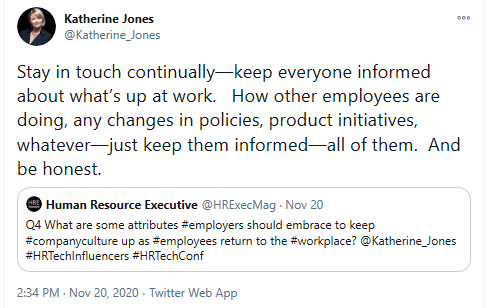Employee safety is top of mind as employers strategize how to get workers back in the workplace, but with no one-size-fits-all solution, what can HR do?
Employers are “in a quandary” when it comes to the state of a return to work, Katherine Jones, an independent thought leader and consultant, said recently during a live Twitter chat with HRE.
“Vaccine supply and distribution is a great unknown as yet—and where ideally every business could get free vaccinations to all employees whether they work remotely or on site; when and how that can happen is an enigma,” Jones, one of HRE’s 2020 HR Tech Influencers, added.
In addition, some employees may resist getting relatively untested new vaccines, she warned; this is something HR organizations need to create a policy for before allowing people back on site.
But there are steps HR leaders can take (or continue to take) as they strategize a return to the workplace. One of the first, she noted, should be to ascertain the risk factor in bringing employees back. And, be transparent with employees.
Related: What Google’s decision to stay remote could mean to other employers
 “Stay in touch continually—keep everyone informed about what’s up at work,” she added. “How other employees are doing, any changes in policies, product initiatives, whatever—just keep them informed, all of them. And be honest.”
“Stay in touch continually—keep everyone informed about what’s up at work,” she added. “How other employees are doing, any changes in policies, product initiatives, whatever—just keep them informed, all of them. And be honest.”
A return-to-the-workplace plan amid a pandemic isn’t the easiest feat, and requires a ton of prep, safety protocols, logistical considerations and robust communication—responsibilities that often fall on the shoulders of human resource professionals.
Jones pointed to tech that could help employers as they strategize reopening plans.
“Contact-tracing and tracking tools are a great example, and necessary to help prevent the spread of COVID-19,” she noted. “Check-in” tools, such as those that have been added to performance management tools like Slack and Microsoft Teams, are also valuable.
Click HERE to take HRE’s What’s Keeping HR Up at Night? survey.
She also listed several safety protocol considerations HR leaders should keep in mind as they plan to reopen the workplace:
-
- Work with facilities managers to deploy desks, work stations and factory machinery at safe distances.
- Add plastic shields as divisions between employees and the public. Provide masks with shields if close physical contact
- Create separate entrances or internal pathways for entering and existing.
- Work toward a “touchless” environment: contactless badges, no keypads, automatic doors, credit cards instead of cash.
- Add lots of hand sanitizer stations; consider robot-driven portable sinks for handwashing.
- Create a policy for that most-debated touchpoint: the elevator; it should cover how many people can ride at once, distance apart and in-elevator behavior. Requiring masks, encouraging no conversation and hand sanitizer by all elevator buttons can cut down spread.
“The call for agility and flexibility is an imperative,” Jones added. “HR professionals are pivotal in making the return to the ‘new-not-so-normal’ work.”